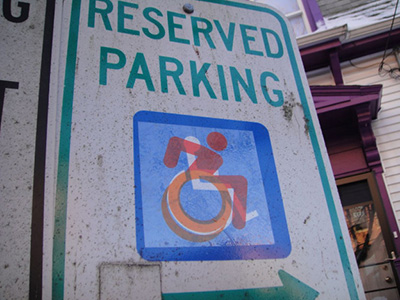
Our December blogger is Xin Sun, a recent Queen’s graduate and an active member of the Queen’s & Kingston communities as a Disability and Social Justice Advocate. In her piece, she discusses the importance of unlearning narrow understandings of disability and accessibility.
As much as having a signage for accessibility for persons with disabilities is important in order to create a barrier-free and an inclusive environment; it is also important to note, not everyone with a disability uses a wheelchair. However, this blog is not to criticize the International Symbol of Access per se, it is aimed to educate and inform the public that, disability is more than the wheelchair. People in the general public, especially the able-bodied population, really needed to have open-mindedness when they encounter someone with a disability.
When someone is identified as disabled and is a wheelchair user, it usually means that the person has limited or loss of mobility. This could be due to an injury or an illness. However, wheelchair users are only a fraction of people with disabilities, and it cannot and should not represent the disabled community entirely. There are other causes and disabilities that one can be identified as having, without using a wheelchair. These people may include: people with chronic and/or terminal illnesses – in most cases, these illnesses are invisible and known as “invisible disabilities;” people with impairments (i.e. Hearing or Vision); people with mental illnesses or disorders; people with intellectual disabilities; people with undiagnosed medical conditions; and, people who don’t always need or use (mobility) aids or devices. Often times, these people with disabilities listed above have their access denied, are discriminated against, and are even shamed when using barrier-free facilities, simply because they aren’t a wheelchair user or their disability is invisible.
Let me give you a personal example. I identify as a person with disabilities. I am vision impaired and I have chronic illnesses. Because of my visual impairment, I use a white cane in public. As you may know, the white cane is a symbol of blindness and visual impairment. With the cane, people around me in public are aware that I am vision impaired. However, while my white cane is a symbol for my visual impairment, my chronic illnesses, are very much invisible. Why? Because I don’t use any aids or devices.
Let’s set up a scenario for you. Let’s say, I try to get on a bus, and I get on the bus with my white cane. People are likely to know that a blind or vision impaired person is getting on the bus, they are likely to try to move out of the way for me, and, they may even help me find a seat in the priority seating area on the bus. However, more often than not, the reason why I needed a seat on the bus, is not just because I am vision impaired; it’s also because, due to my chronic illnesses, I am unable to stand for longer periods of time, and it’s especially difficult to stand in a moving bus. But, it’s very unlikely that people will know about my chronic illnesses, because I don’t “look like” I have any other disabilities, other than the apparent one.
Now, let’s change the scenario a bit, if I get on the same bus, this time without my white cane. What would happen then? Would there be anyone making room for me? Would there be anyone giving up their seat for me? Unlikely. And why is that? That’s because, without my white cane, I don’t fit into the social stereotype of being blind or vision impaired and, let alone others will even notice I have invisible disabilities. From the above example, I hope you realize that, not all disabilities are visible. Disability is also a spectrum. Even putting two people together with the same disability or medical conditions, their lived experiences won’t always necessarily be the same. Therefore, it is so important to recognize, each and every one of us is unique, and this is the same for people with or without disabilities. And having a disability doesn’t always necessarily equal being in a wheelchair either.
Source:
The Accessible Icon Project http://accessibleicon.org/